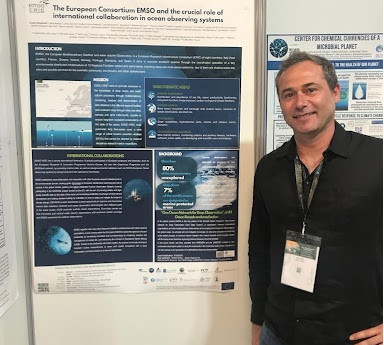
Photo: Simò Cusì, Engineering and Logistics Officer, presented the Consortium poster at the 2024 UN Ocean Decade Conference
Oceanic Challenges and the added value of EMSO international collaboration at the UN Ocean Decade Conference
From April 8 to 12, the UN Ocean Decade Conference in Barcelona saw a week packed with impactful discussions aimed at fostering global partnerships and pledges to further the cause of ocean sustainability and marine science. At the event, the EMSO team showcased the ERIC mission, vision, and objectives through a poster titled 'The European Consortium EMSO and the vital significance of global cooperation in ocean observation systems.' This emphasised the Consortium's efforts in advancing the understanding of deep ocean and water column processes. It highlighted the multidisciplinary data collected from its various Regional Facilities across Europe, enabling continuous, long-term observation of ocean conditions.
Among the international collaborations showcased, a focus was dedicated to two ambitious European projects in which EMSO is deeply involved, the GEORGE and ANERIS projects. Both of these reflect EMSO ERIC's strategic vision to integrate various domains of oceanographic research and foster innovation by leveraging its broad network of observatories and test sites creating a more interconnected and collaborative European marine research landscape to better face the marine and environmental challenges.

As part of the ANERIS project, EMSO is dedicated to supporting the worldwide effort to enhance comprehension and conservation of marine biodiversity. This involves creating innovative scientific instruments and methodologies for detecting marine life, under the concept of Operational Marine Biology (OMB). OMB acts as a comprehensive system for monitoring and understanding oceanic and coastal biodiversity by consistently measuring and interpreting data, thus enabling tracking of responses to environmental shifts.
The objective of this system is to generate FAIR Operational Marine Biology data from a variety of different measurement systems, including underwater imaging, and leverage this data via a distributed IT infrastructure comprising edge and cloud computing nodes that will be connected to the European Open Science Cloud (EOSC). Two EMSO nodes, SmartBay and OBSEA, are working to ensure the uptake and implementation of the developed OMB technologies, in particular through the deployment of imaging flow cytometers to obtain in situ images.
In the GEORGE project, EMSO ERIC collaborates closely with two other European Research Infrastructures, Euro-Argo and ICOS. Together, they focus on developing new technologies and enhancing existing ones, like the EGIM, by incorporating a range of new sensors. These advancements aim to monitor variables related to the carbon cycle, spanning from the ocean's surface to its depths. The project aims to provide high-quality scientific data crucial for understanding changes in the ocean's state, including acidification and its role in CO2 exchange. EMSO plays a significant role in various project tasks, contributing seafloor observation data that complements surface and water column observations from other partners. Moreover, EMSO leads the 'Implementation and Demonstration' aspect, tackling technological challenges head-on. Work Package that will implement and assess the progress of the different technologies and that will demonstrate the multi-RI concept in two large deployments.
Concerning the global context, the EMSO team presented “One Ocean Network for Deep Observation”, a UN Ocean Decade endorsed action led by Ifremer with the collaboration of EMSO ERIC, Japan Agency for Marine-Earth Science and Technology (JAMSTEC) and Ocean Network Canada (ONC), aimed to integrate knowledge on deep-sea ecosystems functioning under global changes, to advance hazard mitigation from natural hazards and to engage citizens with the deep ocean that faces a growing pressure because of human activities.
“One Ocean Network for Deep Observation” was also showcased at the CCIB within the Deeping the Decade booth.